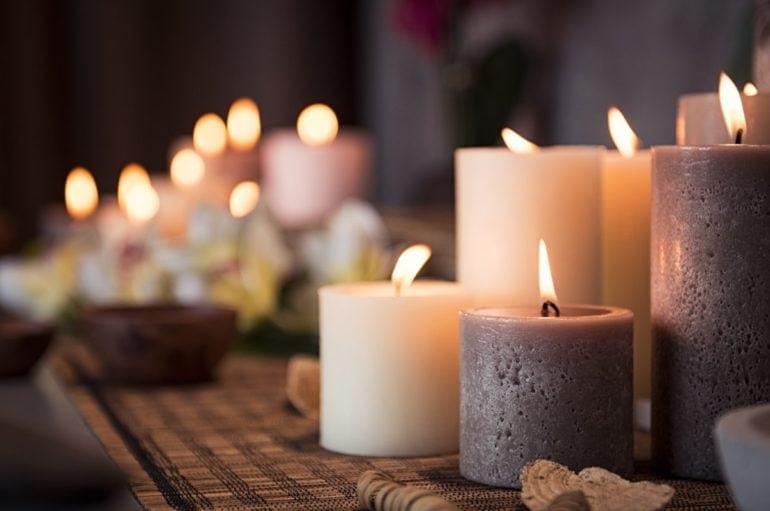Whether you’re using them to set a mood or to light your way during a power outage, candles are a traditional way to add ambiance and illuminate.
Unfortunately, candles can also bring disaster in their wake. While they can enhance the mood and bring warmth to a room, candles must be used safely in order to prevent a fire. Here are some easy tips to follow.
The safest ways to use candles: 15 tips
An estimated 20 percent of candle fires involving fatalities occur during the loss of electrical power. Ideally, you have flashlights and battery-powered lamps to use as are safe sources of light during a power failure — but candles are often a reliable low-tech back-up source of light during lengthy power outages.
To protect your family and home, the National Candle Association, National Association of State Fire Marshals and the US Fire Administration recommend the following precautions if you choose to use candles during a power outage, for a party, or at any time of year.
1. Pillar candles and container candles are a better choice than taper candles, as broader-based candles are less likely to be accidentally knocked over. When possible, candles should be enclosed within glass globes for added protection from burns or fire.
2. Make sure that candles are secured in stable non-flammable holders, such as metal, ceramic, or glass. Anything made of wood or decorated with dried materials or fabric is asking for trouble. A candle should never be used without some sort of holder; otherwise, it can burn down to the surface on which it stands.
3. Place candles on an uncluttered, stable surface in a fire-resistant holder that is at least 12 inches away from anything flammable, including upholstered furniture and window drapes. For added safety when the lights go out, a candle in its holder may be placed on a stable, non-flammable surface, such as a metal cookie sheet, frying pan or ceramic dinner plate.
4. Avoid moving a burning candle during a power outage if possible. It is easy to trip in the dark or brush against something flammable. Container candles may be too hot to handle, causing you to drop the container, which could start a fire.
5. Make sure the candles are well out of the reach of children and pets. Young children are especially apt to bump into things when a room is unfamiliarly dark.
6. Don’t use candles to search for something in a closet or small confined space where clothes, papers or other combustibles could accidentally ignite.
7. Don’t burn a candle all the way down — put it out before it gets too close to the holder or container.
8. Whenever children are in your home, keep candles and matches out of their reach. Never leave a child unsupervised in a room with a lighted candle.
9. Never use a candle where medical oxygen is being used. The two can combine to create a large, unexpected fire.
10. For religious use, if a candle must burn continuously, be sure it is enclosed in a glass container and placed in a sink, on a metal tray, or in a deep basin filled with water.
11. When using in home worship, never place lit candles in windows, where blinds and curtains can close over them, or pass handheld candles from one person to another. To lower the risk of fire, candles should be used by only a few designated adults.
12. Extinguish candles safely by cupping your hand behind the candle flame before blowing it out — or, better yet, snuff out the flame with a metal candle snuffer. A spark or ember, if blown from the candle, could ignite combustibles nearby.
13. Never leave a burning candle unattended. Try to restrict people and candles to one room in the house so the location of family members and candle flames always can be accounted for. Extinguish candles upon leaving a room.
14. Completely put out all candles before going to sleep, and never use a candle as a nightlight.
15. Try candle alternatives — see below for some ideas.
Candle alternatives for scent or light
If you’re looking for the fragrance from candles, and not the illumination, here are a few candle alternatives to consider:
- Battery-operated or electric flameless candles can look, smell and feel like real candles.
- Candle warmers and wax warmers melt scented candles and wax pieces (aka wax melts or tarts, releasing the fragrance without a flame. Popular brands include Scentsy and Yankee Candle,
- Try an oil diffuser instead of a candle.
Fire facts & the safest ways to use candles
During the five-year period of 2006-2010, the The National Fire Protection Association (NFPA) notes the following:
- Roughly one-third (35%) of home candle fires started in bedrooms. These fires caused 42% of the associated deaths and 45% of the associated injuries.
- On average, 32 home candle fires were reported per day.
- Falling asleep was a factor in 11% percent of the home candle fires, and 43% of the associated deaths.
- More than half (56%) of home candle fires occurred when some form of combustible material was left or came too close to the candle.
- December is the peak time of year for home candle fires. In December, 11% of home candle fires began with decorations, compared to 4% the rest of the year. Halloween is also a dangerous holiday for fires.








